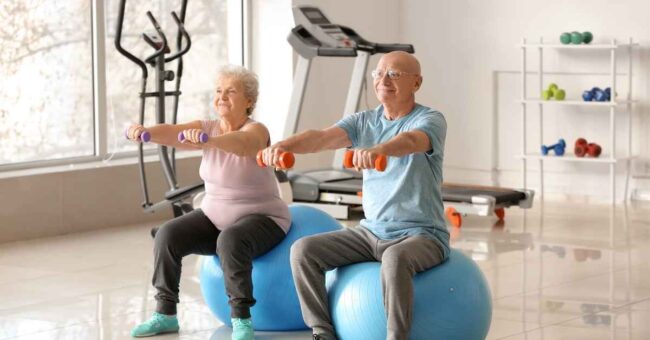Strength Training For Older Adults
Is Strength training good for older adults?
Last updated June 2024
The answer to this question is a resounding yes. Strength training for older adults is ultimately fantastic for better health across all facets. This Systematic review and meta-analysis included 16 studies that were conducted between 2008-2017 and measured a board range of health parameters. The analysis concluded that strength training for older adults yielded significant improvements in health-related quality of life.
In fact, I would argue that strength training for older adults is just about the most important type of training to choose. I touched upon this in my article "benefits of physical exercise for older adults". In this article I'll expand on exactly why strength training for older adults is so important.
Let's clarify exactly what we mean by strength training first of all as it can sound a little bit scary for those who aren't familiar with the terminology. When we say strength training we don't necessarily mean lifting huge barbells above our heads or getting so muscled up we end up looking like Mr Olympia.
Strength training is also often referred to as resistance training and it encompasses broad spectrum of styles and intensity. Often when people hear the words 'strength training' they immediately envisage a gym environment with barbells and dumbbells scattered around.
But strength training can also refer to much gentler training which might be more suitable for older adults and the elderly.
Our strength is simply how well we can manoeuvre our body and things attached to our body (like clothes, shopping bags, pots and pans etc) in relation to gravity. Without gravity there would be no need for strength. That's why when astronauts spend time in space they have to dedicate a significant amount of time doing strength based exercises.
If they didn't their muscles would waste away (muscle atrophy) quite quickly.
It's our muscles that provide us with strength. Our muscles pull on our bones to move our joints. Our muscles go through a natural lifecycle. When we're born they are extremely weak, hence why babies can't walk or even sit up. Over time our muscles develop and become strong enough for us to be able to move around. They adapt the gravity's force and become strong enough to overcome it. Other factors such as coordination and balance also play a role.
Eventually, as we age our muscles naturally begin to decline in size and strength. Eventually, without doing any exercise, they become so weak that we often struggle to perform basic movements such as walking, sitting down, standing up or picking up objects.
There is a clear correlation between inactivity and muscle atrophy. Seniors and elderly people who are institutionalised in care homes often don't do much activity at all. If we spend most of our time sitting and lying down then muscle atrophy will occur more quickly.
Thankfully we can choose to do certain things that manipulates our muscles natural life cycle. Specific nutrition protocols and exercises are the 2 key things we can do to keep our muscles strong.
As I just mentioned, as we age our muscles start to weaken. This muscle atrophy, without resistance exercise, probably starts in the 40's and get progressively worse.
What's even more problematic is the rate at which the muscles weaken with age. Without exercise intervention you could lose 50% of your muscle mass by the time you reach 80.
Add to these issues the potential for chronic age related syndromes such as sarcopenia which only exacerbates muscle atrophy even further, there is a real problem that needs to be addressed on a global scale.
As it stands, no where near enough older adults are participating in strength training exercise and as a result we have an ageing population that is struggling with mobility and losing their independence.
How often should seniors do strength training?
Strength training for older adults and the elderly needs to be done regularly. Without regularity you won't reap the benefits of increased muscle strength and mass.
Our bodies are incredibly adaptable and will only stay as strong as the stimulus you provide it. Without what's called 'progressive overload' your muscles will stop getting stronger.
Progressive overload is as it sounds. It's when you progressively overload the muscle with weight to force them to continue to grow and become stronger.
How many times a week should Seniors lift weights?
Strength training or resistance training should done be between 2-5 x per week depending on what level you're starting off from.
If you are in your 70's or 80's and have been living a sedentary lifestyle for many years then it's sensible to start off doing 2 strength sessions per week.
If you are a bit younger, in your 50' and 60's and are already fairly active you could try doing 2-3 sessions per week. As you get stronger and your body becomes better at adapting the regular stimulus you are providing it, you could do more sessions if you wanted.
As a minimum I would start with 2 sessions per week are try and get to 3 sessions per week over time.
How can seniors develop strength?
By doing regular resistance training and implementing progressive overload over time your strength will develop.
The methodology of developing strength is the same across all age groups.
Strength training for older adults just has to be set up a little differently sometimes. And there are several reasons for this.
Arthritis
Arthritis is very common in older adults and seniors and it can make exercise a very daunting task. There hundreds of types of arthritis but the type most commonly seen in older adults and the elderly is osteoarthritis. You can read more about arthritis in this article.
Around 70% of older adults above the age of 65 have some degree of osteoarthritis. The most common places are the knees, hips and hands but other joints can be affected.
People suffering with osteoarthritis are often scared to exercise believing that it will cause further damage to the joint. This isn't the case as long as the chosen exercises are appropriate. In fact exercise is one the best treatments for osteoarthritis.
Balance and coordination
Balance and coordination can be affected with age. It is estimated that 13% of adults self‐report imbalance from ages 65 to 69. This can due to things such as age related sensory decline and vision problems. For older adults and seniors who have issue with balance and coordination certain resistance based exercises should be avoided. Depending on how severe the issues are, resistance training can be done whilst sitting down.
Home based training
Most of the clients we work with in the Wise Fitness Academy do their training at home. The gym can be inaccessible for some older adults and others are simply too intimidated to go. Most gyms don't cater too well for strength training for older adults.
Home based strength training for older adults is perfectly viable and actually a really effective. The Wise Fitness Academy has dozens of resistance based home workouts ranging from total beginner to the more advanced.
What are the best strength training exercises for seniors?
As I have already alluded to, resistance training should be adapted to suit individual needs and requirements.
However there are some broad concepts of strength training that should adhered to as much as possible.
Full body workouts
The bodies skeletal and muscular systems work as one. Certain injuries or imbalances don't only effect one specific muscle or joint.
For example, someone suffering an arthritic knee might suffer from back or/and hip pain as a result. This might be because that person is overcompensating on their stronger side causing an imbalance. The stronger side ends up taking the brunt of the weight during everyday movements and overtime pain may develop as a result.
That's why it's important to to exercise all the muscles in the body and not just as select few. The aim should be to get stronger everywhere.
Compound vs isolation exercises
When it comes to strength training for older adults compound exercises are king.
A compound exercise is when 2 or more joints are moving or 2 or more muscles are working during the exercise.
For example, during a squat (going from standing to sitting) the hip and knee joints are moving and the quads, hamstrings and glutes are working. So the squat is a compound exercise.
During a shoulder raise (when you bring your up up in front of you) only the shoulder joint is moving and only the shoulder muscle is working. So this would be an isolation exercise.
Compound exercises give you more bang for your buck. They are generally safer to perform and you can lift more weight when doing them because multiple muscle groups are working together.
When we train our Wise Fitness Academy clients we always start with compound exercises first and move onto isolation exercise.
However, it is client dependent. Factors such as arthritis, level of mobility, level of strength, confidence etc can impact what exercise we choose to do.
Strength training exercises can be done using a variety of equipment including bodyweight, resistance bands, dumbbells and barbells, medicine and swiss balls to name a few.
There is always a work around. There is always another way. If a certain exercise causes pain then there is another exercise you can do instead.
What are the 5 basic strength training exercises?
To give you an idea of some good exercises I have listed 5 below. All of these exercises are great examples of strength training for older adults.
Squats
Squats imitate the sitting to standing movement pattern. They are a fantastic compound exercise and one that we use with clients all the time. Think about how often you move from a standing to sitting position during everyday life. A lot! The ability to squat with relative ease is a great marker of decent strength and mobility.
Lunges
Lunges are another great lower body exercise. They work one leg at a time which can be really useful to identify and work on strength imbalances. They can be a bit tricker to perform but there are lots of variation and tricks to make them manageable.
Glute bridges
Glute bridges are performed whilst lying on your back so you do need to able confidently get into that position. They work the glutes predominantly which is the biggest muscle group in the body and surrounds your bum area.
Shoulder press
These are a great upper body exercise that work the shoulders, chest, traps (in the upper back) and triceps (back of the arm). They are best performed with dumbbells.
Push ups
They can sound a bit scary and daunting but there are loads of variations that can make push ups suitable for beginners. They work chest, shoulder and triceps (back of the arms)
Can you rebuild muscle after 60?
Absolutely. In fact this article talks about a landmark 1994 study that was conducted among care home residents between the ages of 72-94. They all did resistance training 3 x a week for 10 weeks. The resulting increases in fitness, mobility and strength was amazing.
It doesn't matter what your strength and fitness levels are right now. Anyone can start resistance training and get stronger.
Is strength training effective for 70 year olds?
The benefits of strength training for older adults doesn't discriminate by age. Whether you're in your 50's or your 90's strength training can be done and will have significant benefits to your health.




